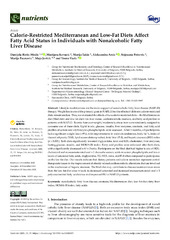Приказ основних података о документу
Calorie-Restricted Mediterranean and Low-Fat Diets Affect Fatty Acid Status in Individuals with Nonalcoholic Fatty Liver Disease
| dc.creator | Ristić-Medić, Danijela | |
| dc.creator | Kovačić, Marijana | |
| dc.creator | Takić, Marija | |
| dc.creator | Arsić, Aleksandra | |
| dc.creator | Petrović, Snježana | |
| dc.creator | Paunović, Marija P. | |
| dc.creator | Jovicić, Maja | |
| dc.creator | Vučić, Vesna M. | |
| dc.date.accessioned | 2021-04-20T13:11:04Z | |
| dc.date.available | 2021-04-20T13:11:04Z | |
| dc.date.issued | 2021 | |
| dc.identifier.issn | 2072-6643 | |
| dc.identifier.uri | http://rimi.imi.bg.ac.rs/handle/123456789/1071 | |
| dc.description.abstract | Lifestyle modifications are the main support of nonalcoholic fatty liver disease (NAFLD) therapy. Weight loss is one of the primary goals in NAFLD, but the effects of different calorie-restricted diets remain unclear. Thus, we evaluated the effects of two calorie-restricted diets-the Mediterranean diet (Med diet) and low-fat diet-on liver status, cardiometabolic markers, and fatty acid profiles in patients with NAFLD. Twenty-four overweight/moderately obese men were randomly assigned to consume one of these diets. Lipid levels, glucose, insulin, liver enzymes, steatosis, and fatty acid profiles of serum and erythrocytes phospholipids were assessed. After 3 months, all participants had a significant weight loss ( gt 9%), with improvements in waist circumference, body fat %, index of visceral adiposity (VAI), lipid accumulation product, fatty liver (FLI), and hepatic steatosis (HSI) index (p lt 0.001). Both diets significantly lowered triglycerides, total and LDL-cholesterol, liver enzymes, fasting glucose, insulin, and HOMA-IR index. Fatty acid profiles were enhanced after both diets, with a significantly decreased n-6/n-3 ratio. Participants on the Med diet had higher levels of HDL-cholesterol and monounsaturated and n-3 docosahexaenoic acids in serum phospholipids and lower levels of saturated fatty acids, triglycerides, TG/HDL ratio, and FLI when compared to participants on the low-fat diet. Our results indicate that dietary patterns and calorie restriction represent central therapeutic issues in the improvement of obesity-related cardiometabolic alterations that are involved in the mechanism of hepatic steatosis. The Med diet may contribute to disease treatment even more than the low-fat diet since it leads to decreased saturated and increased monounsaturated and n-3 polyunsaturated fatty acid status and improved FLI in NAFLD patients. | en |
| dc.publisher | MDPI | |
| dc.relation | info:eu-repo/grantAgreement/MESTD/inst-2020/200015/RS// | |
| dc.rights | openAccess | |
| dc.rights.uri | https://creativecommons.org/licenses/by/4.0/ | |
| dc.source | Nutrients | |
| dc.subject | nonalcoholic fatty liver disease | en |
| dc.subject | steatosis | en |
| dc.subject | Mediterranean diet | en |
| dc.subject | low-fat diet | en |
| dc.subject | fatty liver index | en |
| dc.subject | HOMA-IR index | en |
| dc.subject | fatty acids | en |
| dc.title | Calorie-Restricted Mediterranean and Low-Fat Diets Affect Fatty Acid Status in Individuals with Nonalcoholic Fatty Liver Disease | en |
| dc.type | article | |
| dc.rights.license | BY | |
| dc.citation.issue | 1 | |
| dc.citation.other | 13(1): - | |
| dc.citation.rank | M21~ | |
| dc.citation.spage | 15 | |
| dc.citation.volume | 13 | |
| dc.identifier.doi | 10.3390/nu13010015 | |
| dc.identifier.fulltext | http://rimi.imi.bg.ac.rs/bitstream/id/56/1068.pdf | |
| dc.identifier.pmid | 33374554 | |
| dc.identifier.scopus | 2-s2.0-85098666390 | |
| dc.identifier.wos | 000610641500001 | |
| dc.type.version | publishedVersion |

